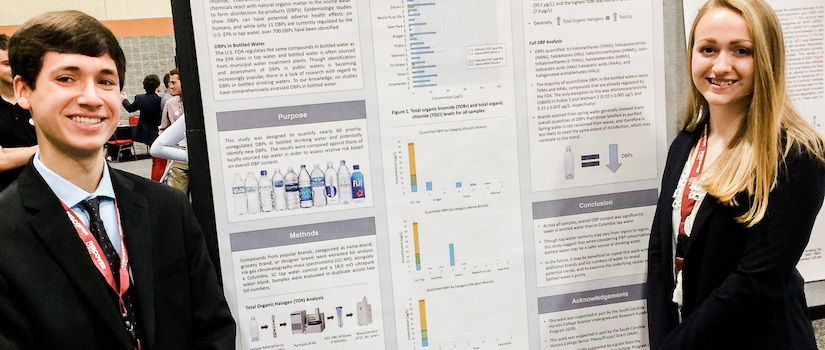Two Honors students’ award-winning research gets closer to the answer
Posted on: June 24, 2019
By Aïda Rogers, AIDAR@mailbox.sc.edu
For environmental chemistry professor Susan Richardson, it’s a question she hears
a lot: Is bottled water safer to drink than tap? To help find the answer, she enlisted
Honors biochemistry students Gretchen Bollar and Anthony Kocur. The pair spent a year
and a half analyzing 20 cases of 10 brands of bottled water, as well as tap water
and their control “ultrapure” water. Their ground-breaking research earned them the
2019 William A. Mould Outstanding Senior Thesis Award.
“This thesis project demonstrates a significant contribution to the field of environmental
chemistry and public health and answers a long-standing question regarding chemicals
present in bottled water,” Richardson wrote in her nomination letter for the prize.
“Their work enabled the first comprehensive look at the chemicals present in bottled
water.”
What did the young scientists find? Basically, that bottled water – at least the “designer”
brands of evian, FIJI Water and smartwater; the “name” brands of Aquafina, Dasani,
Deer Park and Nestle Pure Life; and the “grocery” brands of Kroger, Publix, and Walmart’s
Great Value – has fewer disinfection by-products than tap. That’s a good thing, because
many DBPs have been identified as “highly toxic,” Richardson noted.
“While it was suspected that bottled water might have lower levels of DBPs and other
chemicals than tap water, no one had ever investigated this before,” she wrote. Bollar
and Kocur’s thesis director, Richardson described how her students quantified 70 DBPs
– regulated and unregulated – and quantified total organic chlorine, bromine, and
iodine, and conducted non-target analysis using mass spectrometry to identify any
other chemicals in their test waters.
“Enjoyable, strenuous, and applicable to everyone” is how Kocur, from Cary, North
Carolina, describes the research. “Sometimes the work would get frustrating due to
slow-moving experimental procedures or it would take much longer than expected, but
I could never call it boring.” After a gap year, Kocur plans to enter medical school.
“This project really proved to me that if I set my mind to a task, I’m going to see
it through,” Bollar says. “There were times when I was frustrated or busy and didn’t
want to work anymore, but I kept going because I knew the end result would be worth
it. Working in the lab also helped me realize my passion for research.”
Bollar, from Tega Cay, South Carolina, will enter the PhD program in biomedical sciences
at the University of Alabama at Birmingham this fall.
One of the joys of research is stumbling on a surprise. For Bollar, it was learning
that “purified” bottled water comes from municipal treatment plants.
“So for example, the City of Columbia could sign a deal with a major bottling company
and allow them to use their water for a fee,” Bollar says. “This is totally legal,
as long as the finished water meets specific purification standards. This finding
was one of the main reasons we thought DBPs might be present in bottled water.”
For Kocur, an interesting discovery occurred when he found a higher level of haloacetic
acids in FIJI Water. “Volcanic rock contains components that may support the formation
of DBPs,” he says. FIJI water, according to its website, is made from rain “filtered
through layers of volcanic rock.”
So intensive was the research that Bollar and Kocur, friends since freshman year,
worked 14-hour days and cut holidays short to attain conclusive evidence. “Their motivation
and perseverance are unmatched,” Richardson wrote. “They are truly remarkable.”
The results of their research, funded by Magellan, SURF, and Honors Thesis grants,
will be submitted to a scientific journal. Bollar and Kocur are joint first authors;
Richardson and her graduate students Amy Cuthbertson, Josh Allen, and Hannah Liberatore,
who assisted and helped oversee the project, will also be coauthors.
The researchers stress that their work wasn’t designed to test which brand of bottled
water is the safest, best, or cleanest—only which waters have fewer DBPs.
“We really didn’t see anything that made a single brand stand out dramatically from
the others,” Bollar says. She and Kocur say they’re comfortable drinking the bottled
waters they tested, understanding that they have much lower levels of DBPs compared
to what comes out of the kitchen.
Still, Richardson is not necessarily suggesting that everyone start drinking bottled
water.
“It’s important to note that bottled water is not regulated in the same way that our
tap water is, and our drinking water treatment plants do a great job of killing the
harmful bacteria to make it safe to drink,” she says. “At the same time, my group
is investigating the use of granular activated carbon to remove DBP precursors and
reduce DBP formation in our tap water. This would be like having a giant Brita filter
at the drinking water treatment plant. So far, the results are promising. The goal
of our research is to make good drinking water safer.”
But, as freshly graduated college students, can Bollar and Kocur afford to buy their
water? Bollar has found her own solution. “There’s always the option of a good filter,”
she says.
Established in 2015, the William A. Mould Outstanding Senior Thesis Award honors the
legacy of Dr. William A. Mould, a founding dean of the South Carolina Honors College.
Mould instituted the senior thesis requirement as the ideal capstone experience for
graduating seniors. The award recognizes the Honors College senior whose thesis demonstrates
the highest levels of rigor, creativity and scholarly impact in his or field. Students
are nominated by a thesis director and the winner is chosen by a committee. Given
by Mould’s family, the award includes a $1,000 prize. This is the first time the award
has been given to students working on a joint thesis project.
